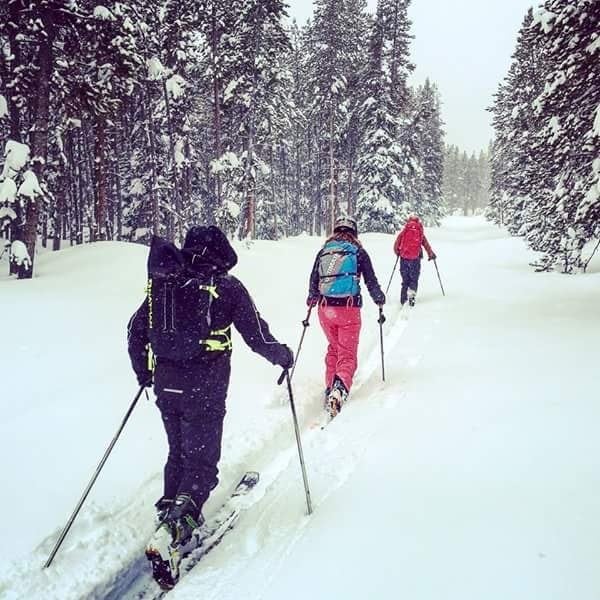“Lean back,” said the voice in my wake. “It helps if you lean back.” It was January 10th and we were ski touring on a glorious winter day in the Colorado backcountry. Okay, let me rephrase that, Hillary, Pete, and Jeremiah were skiing. I was learning. Pete may have said that he was learning, but let’s be honest, as an experienced split-boarder and the head of Pikes Peak Alpine School, he was far from a backcountry noob. Sure, descending on two planks instead of one may have been a work in progress for him, but he was definitely quite a few steps, or skin strides, ahead of me.
They had put me out front to break trail. I was happy to do it. “Make use of me while you can,” I had said, acknowledging that I wouldn’t be very helpful once the terrain went downhill or required more extensive navigation skills. I was a set of legs and lungs that day. That and a corny joke was about all I was good for. And yet, at times, I was struggling. The powder was deep and the terrain was steep.
Apparently the combination of those two things requires a bit more skill and technique than skinning up a groomed resort hill. In running, climbing is pretty simple. You find your footing, put your head down, and grind. Even if your technique isn’t perfect you can still make decent progress. When skinning on skis, however, the technique is crucial to making forward progress. On gradual terrain it isn’t all that difficult. The process is more forgiving as you can often make forward progress even if your weight isn’t distributed in just the right way. On steeper terrain, proper technique becomes a lot more important. If you fail to distribute your weight properly the skins on the bottom of your skis can’t get a good hold on the snow beneath them and your ski slips backwards.
Sometimes I shifted my weight correctly and did alright. Other times it felt like I was one step forward and two steps back. I was fit and strong, but my technique was holding me back. It was frustrating. With a dry trail and shoes on my feet, I can charge up hill just fine. But here in the deep powder with skis on my feet and poles in my hands, I felt like a fish out of water. The voice from behind continued. The intentions were good. But to be honest, it was aggravating. I am a very independent person. I didn’t want someone telling me what to do. I wanted to figure it out on my own, to prove myself capable.
Fortunately for those around me, I managed to control my frustrations. I thanked the voice and tried hard to be teachable. In the end it all worked out great. I laughed at myself as I took a less-than-graceful stab at skiing downhill. Sometimes I did alright. Other times I barely stayed upright. And let’s be honest, a few times I had to dig myself out of the powder and awkwardly find my feet.
Looking back I see value not only in the moments of fun, but also in the process of learning something new. Too often in life we are afraid to get out of our comfort zone. We stick to what we know, focus on what we’re good at, and steer clear of the unfamiliar. Sometimes it works out great as we hone our skills and accomplish great things. If we do this for too long, however, we run the risk of becoming stagnant.
To avoid this issue we must be willing to break out of our comfort zone and try something new. Doing so can be quite difficult as it challenges us in all sorts of ways. The learning process keeps no secrets as it unearths our weaknesses and demands more of us. And it’s not just a physical demand, but a mental and emotional one as well. All too often we find ourselves thinking and reacting in the same sort of way. While consistency can be good, and sticking to values is important, we must be careful not to do so to a fault.
When we challenge ourselves with new endeavors, we force our bodies and minds to work in a different way. Just like me learning to ski uphill on steep terrain, I needed to teach myself how to think. My running brain wanted to lean into the climb, but the more knowledgeable skier behind me said to lean/sit back. It was hard. It was frustrating. It was worth it. Worth it not only because it helped me develop as a person, but also because sometimes life throws us challenges that we don’t get to choose.
These unchosen circumstances can come in a variety of ways. For me, I’m reminded of my time spent working on cruise ships. Living in America I am very used to being part of the majority, but on a ship full of Nepalese, South Africans, Filipinos, and many other races, I was very much in the minority. Immersing myself in that sort of environment was incredibly valuable as it exposed me to many different ways of thinking. I could have been resistant, choosing to shut everyone out. Instead I made friends and opened myself up to different world views. I allowed myself to be teachable, to learn from those around me, and in the end I emerged a stronger, better, more informed person.
Whether our challenges are a matter of environmental or social circumstance, it’s important that we be able to respond in a positive manner. Sure, we don’t always get what we want. But life isn’t about that. It’s about learning to react, respond, and roll with the punches. It’s about taking all the stuff that life throws at us and using it to become better, stronger, more influential people. So do yourself a favor. Take on a new challenge. Learn something new. Get out of your comfort zone. Though it may be hard at first, the skills and traits you develop will be very valuable when the unexpected avalanches come your way.
Call for Comments (from Meghan)
- What does being ‘teachable’ mean to you?
- How often do you put yourself in new sets of circumstances so that you can keep learning and growing as a human?
- Does remaining malleable become more or less difficult for you as you age?

Photo: Pete Lardy
